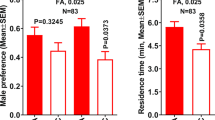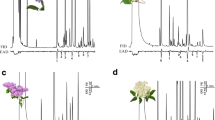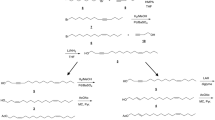Abstract
The Asian longhorned beetle (ALB), Anoplophora glabripennis, is a well-known stem borer with high polyphagous properties causing frequent outbreaks in northeast China. An attractant-based trap is needed to improve the sensitivity, reliability, and efficiency for detection of the beetle. In this study, the effects of attractants, trap types and color synergy of a trapping system were evaluated. Attractant blends comprised of the male-produced, two-component pheromone plus plant volatiles were used in the field in Hengshui city. Plant volatiles (e.g., 1-pentanol, and 2-pentanol) in combination with male pheromones increased the mean number of trapped ALB compared to the pheromone alone. Males responded better than females to traps baited with plant volatiles alone, whereas traps emitting plant volatiles plus pheromone, regardless of trap type, captured more females than males. The ALB-trapping efficiency of a modified flight intercept panel trap was more than ten times as high as a woodborer panel trap and 1.2 times a flight intercept panel trap. The 1-pentanol and 2-pentanol attractants alone or in combination with male-produced pheromone were more effective for monitoring ALB than common lures. In laboratory Y-tube olfactometer experiments, the color brown was better at increasing attraction of both males and females to 1-pentanol, 2-pentanol, 1-pentanol + pheromone, and 2-pentanol + pheromone compared to the clear-glass control arm. The findings provide a reliable and effective trap system to monitor ALB infestations.











Similar content being viewed by others
References
An L, Neimann A, Eberling E, Algora H, Brings S, Lunau K (2018) The yellow specialist: dronefly Eristalis tenax prefers different yellow colours for landing and proboscis extension. J Exp Biol 221(22):jed184788
Arikawa K (2017) The eyes and vision of butterflies. J Physiol 595(16):5457–5464
Bu ZG, Du SH, Zhang Y (2003) Occurrence situation and control countermeasures of in urban green space. Agricultural University of Hebei, Baoding
Campbell SA, Borden J (2006) Integration of visual and olfactory cues of hosts and non-hosts by three bark beetles (Coleoptera: Scolytidae). Ecol Entomol 31(5):437–449
Crook DJ, Khrimian A, Cossé A, Fraser I, Mastro VC (2012) Influence of trap color and host volatiles on capture of the emerald ash borer (Coleoptera: Buprestidae). J Econ Entomol 105(2):429–437
Defago MT, Videla M, Valladares G (2016) To smell you better: prior food deprivation increases herbivore insect responsiveness to host plant odor cues. J Insect Behav 29(5):527–534
Domingue LM, Lelito JP, Myrick AJ, Csoka G, Szocs L, Imrei Z, Baker TC (2016) Differences in spectral selectivity between stages of visually guided mating approaches in a buprestid beetle. J Exp Biol 219(18):2837–2843
Fan LQ, Yan SC, Sun ZH, Meng ZJ (2003) EAG and behavioral responses of Asian longhorned beetle Anoplophora glabripennis (Coleoptera: Cerambycidae) to plant volatiles. Chin J Ecol 32(1):142–148 (in Chinese)
Fan LQ, Yan SC, Sun ZH (2013) The electroantennogram and behavior reaction of Anoplophora glabripennis to plant volatiles. Chin J Ecol 32(1):142–148 (in Chinese)
Ginzel MD, Hanks LM (2005) Role of host plant volatiles in mate location for three species of longhorned beetles. J Chem Ecol 31(1):213–2127
Golec JR, Li F, Cao LM, Wang XY, Duan JJ (2018) Mortality factors of Anoplophora glabripennis (Coleoptera: Cerambycidae) infesting Salix and Populus in central, northwest, and northeast China. Biol Control 126(11):198–208
Guan Z (2010) The investigation of Anoplophora glabripennis occurrence regularity and damage in Harbin. Northeast Forestry University, Harbin
Haack BRA, Law KR, Mastro VC, Ossenbruggen S, Raimo BJ (1997) New York’s battle with the Asian longhorned beetle. J for 95:11–15
Hurb M, Shivam B, Antonia M (2019) Male Bicyclus anynana butterflies choose females on the basis of their ventral UV-reflective eyespot centers. J Insect Sci 19(1):1–8
Jiggins CD, Naisbit RE, Coe RL, Mallet J (2001) Reproductive isolation caused by colour pattern mimicry. Nature 411(6835):302–305
Jin YJ, Li JQ, Li JG, Luo YQ, Stephen AT (2004) Olfactory response of Anoplophora glabripennis to volatile compounds from Ash-Leaf (Acer negundo) under drought stress. Sci Silvae Sin 40(1):99–105
Ju Q, Guo X, Li X, Jiang XJ, Jiang XG, Ni WL, Qu MJ (2017) Plant volatiles increase sex pheromone attraction of Holotrichia parallela (Coleoptera: Scarabaeoidea). J Chem Ecol 43(3):236–242
Ladd TL, Klein JMG (1986) Japanese beetle (Coleoptera: Scarabaeidae) response to color traps baited with phenethyl propionate + wugenol + geraniol (3:7:3) and Japonilure. J Econ Entomol 79:84–86
Lefuleselen L, Zeyaurr K, Ahmed H (2011) Responses of the blister beetle Hycleus apicicornis to visual stimuli. Physiol Entomol 36(3):220–229
Li DJ, Tokoro M, Nacashima T (1999) Mechanism of mating action of Anoplophora glabripennis Motschulsky. J Beijing for Univ 21:33–36 (in Chinese)
Li JG, Jin YJ, Luo Q, Xu ZC, Chen HJ (2003) Leaf volatiles from host tree Acer negundo: diurnal rhythm and behavior responses of Anoplophora glabripennis to volatiles in field. Acta Bot Sin 45(2):77–182
Li LY, Meng QF, Li Y, Gao WT (2015) Relative efficiency of three trap types for monitoring longhorn beetles (Coleoptera: Cerambycidae). Chinese Journal of Applied Entomology 52(5):1305–1311
Nehme ME, Keena MA, Zhang A, Baker TC, Hoover K (2009) Attraction of Anoplophora glabripennis to male-produced pheromone and plant volatiles. Environ Entomol 38(6):1745–1755
Nehme ME, Keena MA, Zhang A, Baker TC, Xu Z, Hoover K (2010) Evaluating the use of male-produced pheromone components and plant volatiles in two trap designs to monitor Anoplophora glabripennis. J Chem Ecol 39(1):169–176
Nehme ME, Trotter RT, Keena MA, McFarland C, Coop J, Hull-Sanders HM, Meng P, De Moraes CM, Mescher MC, Hoover K (2014) Development and evaluation of a trapping system for Anoplophora glabripennis (Coleoptera: Cerambycidae) in the United States. Environ Entomol 43(4):1034–1044
Nowak DJ, Pasek JE, Sequeira RA, Crane DE, Mastro VC (2001) Potential effect of Anoplophora glabripennis (Coleoptera: Cerambycidae) on urban trees in the United States. J Econ Entomol 94(1):116–122
Poland TM, McCullough DG (2014) Comparison of trap types and colors for capturing emerald ash borer adults at different population densities. Environ Entomol 43(1):157–170
Proffit M, Birgersson G, Bengtsson M, Reis R, Witzgall P, Lima E (2011) Attraction and oviposition of Tuta absoluta females in response to tomato leaf volatiles. J Chem Ecol 37(6):565–574
Rassati D, Marini L, Marchiori M (2019) Developing trapping protocols for wood-boring beetles associated with broadleaf trees. J Pest Sci 92(1):267–279
Saint-Germain M, Buddle C, Drapeau P (2007) Primary attraction and random landing in host-selection by wood-feeding insects: a matter of scale? Agric for Entomol 9(3):227–235
Sarvary MA, Cooperband MF, Hajek AE (2015) The importance of olfactory and visual cues in developing better monitoring tools for Sirex noctilio (Hymenoptera: Siricidae). Agric for Entomol 17(1):29–35
Setamou M, Sanchez A, Salda ARR, Patt JM, Summy R (2014) Visual responses of adult Asian citrus psyllid (Hemiptera: Liviidae) to colored sticky traps on citrus trees. J Insect Behav 27(4):540–553
Silk PJ, Ryall K, Mayo P, Lemay MA, Grant G, Crook D, Cosse A, Fraser I, Sweeney JD, Lyons B, Pitt D, Scarr T, Magee D (2011) Evidence for a volatile pheromone in Agrilus planipennis Fairmaire (Coleoptera: Buprestidae) that increases attraction to a host foliar volatile. Environ Entomol 40(1):904–916
Strangi A, Peverieri GS, Roversi PF (2012) Managing outbreaks of the citrus long-horned beetle Anoplophora chinensis (Forster) in Europe: molecular diagnosis of plant infestation. Pest Manag Sci 69:627–634
Strom BL, Goyer RA (2001) Effect of silhouette colour on trap catches of Dendroctonus frontalis (Coleoptera: Scolytidae). Ann Entomol Soc Am 94(6):948–953
Tadele S, Emana G (2017) Evaluation of colored sticky traps for the monitoring of Tuta absoluta Meyrick (Lepidoptera: Gelechiidae) in tomato under glasshouse in Ethiopia. Agri Res Tech 9(3):555762
Tang YC, Zhou CL, Chen XM (2013) Visual and olfactory responses of seven butterfly species during foraging. J Insect Behav 26(3):387–401
USDA-APHIS (2013) (U.S. Department of Agriculture, Animal Plant Health Inspection Service). Asian Longhorned Beetle Cooperative Eradication Program in Clermont County, Ohio. http://www.aphis.usda.gov/plant_health/ea/downloads/2012/ALB-OHClermontCountyRevisedEA.pdf
Van der Kooi CJ, Stavenga DG, Arikawa K, Belusic G, Kelber A (2021) Evolution of insect color vision: From spectral sensitivity to visual ecology. Annu Rev Entomol 66:435–461
Wickham JD, Xu ZC, Teale SA (2012) Evidence for a female-produced, long- range pheromone of Anoplophora glabripennis (Coleoptera: Cerambycidae). Insect Sci 19(3):355–371
Wong JC, Zou Y, Millar JG, Hanks LM (2017) Attraction of Cerambycid beetles to their aggregation-sex pheromones is influenced by volatiles from host plants of their larvae. Environ Entomol 46(3):649–653
Xu H, Turlings TCJ (2018) Plant volatiles as mate-finding cues for insects. Trends Plant Sci 23(2):100–111
Yv FL, Hai XX, Wang ZG, Yan AH, Liu BX, Bi YG (2015) Integration of visual and olfactory cues in host plant identification by the Asian longhorned beetle, Anoplophora glabripennis (Motschulsky) (Coleoptera: Cerambycidae). PLoS ONE 10(11):e0142752
Zhang AJ, Oliver E, Aldrich JR, Wang B, Mastro VC (2002) Stimulatory beetle volatiles for the Asian longhorned beetle, Anoplophora glabripennis (Motschulsky). Z Naturforschung J Biosci 57(5–6):553–558
Zhang FJ, Wu XY, Yang L (2007) Supercritical CO2 extraction in Acer mono volatiles and research on the olfactory sensation of Anoplophora glabripennis based on the volatiles. For Sci 143:146–150
Author information
Authors and Affiliations
Contributions
JY, YZ and DJ have contributed equally to this work and share co-first authorship.
Corresponding authors
Additional information
Publisher's Note
Springer Nature remains neutral with regard to jurisdictional claims in published maps and institutional affiliations.
Project funding: This study was supported by the Fundamental Research Funds for the Central Universities (2572021BK01).
The online version is available at http://www.springerlink.com.
Corresponding editor: Tao Xu.
Rights and permissions
Springer Nature or its licensor (e.g. a society or other partner) holds exclusive rights to this article under a publishing agreement with the author(s) or other rightsholder(s); author self-archiving of the accepted manuscript version of this article is solely governed by the terms of such publishing agreement and applicable law.
About this article
Cite this article
Yan, J., Zhou, Y., Jiang, D. et al. Evaluation of trap efficiency for the Asian longhorned beetle, Anoplophora glabripennis. J. For. Res. 34, 1133–1144 (2023). https://doi.org/10.1007/s11676-022-01550-w
Received:
Accepted:
Published:
Issue Date:
DOI: https://doi.org/10.1007/s11676-022-01550-w




